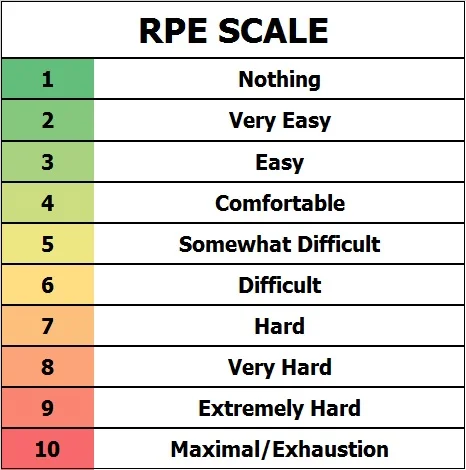Monitoring put simple
When it comes to monitoring athletes, it can become a difficult task to quantify their volume and intensities. In my current position, I am lucky enough to be supplied with the greatest monitoring tools available. I am writing this post for those who are looking to monitor their athletes and a VERY cost efficient way. My solution; session RPE.
RPE
Rate of perceived exertion: This is an internal-subjective variable used to monitor the athletes loads. In an ideal setting, you would have multiple aspects (external and internal/subjective and objective). However, that may not always be feasible.
Collecting RPE is as simple as asking the athlete how they feel after a session (1-10). Based on Borg's Scale [1] I have built my own RPE graph which is very simple and easy to read. The aspects I wanted to include are; numbers, colours, and choice of words. I have labelled each number with a word that the athlete can associate their feeling with, that way I can quantify their perception. Below is the RPE scale that I put together;
MEASURE
In an ideal setting, you would collect RPE for every individual, for every activity (including S&C, training, games etc). For the sake of simplicity, I will only discuss quantifying practice loads. After all, this is the hardest thing to measure as a Sports Performance coach, because a lot of the time, the prescriptions are out of one's control.
INTERPRETATION
RPE can be interpreted in multiple ways. If you do not have access to heart rate monitors, gps units, or any other quantifiable collection method, session RPE can be calculated to obtain an arbitrary unit.
Session RPE (sRPE) load = RPE x duration
eg. 5 x 60 minutes = 300 Arbitrary units
This arbitrary unit can collected over a long period of time and can be a resource of comparing daily stress. For example, even though a training session may be shorter, there can be multiple variables that determine how stressful the session really is. You may have an athlete who would consider an average session to be a 5 (somewhat difficult). However, the same planned session could be given the day after a game, in the heat, after a poor night sleep etc. After the variables, the same athlete may rate the exact same session as a 7 (Hard). This absolutely needs to be taken into account, because after all;
PERCEPTION IS REALITY!
A coach or practitioner may evaluate the session as easy, but if the athlete considers it stressful (determined by RPE), then this needs to be recorded. By monitoring and recording every (or most) planned applied stress, the practitioner is able to quantify those and evaluate whether or not you are obtaining the desired adaptations. The onset of applied stress should match your planned macrocycle in order to aid the athlete's physical (and psychological) preparation for games.
INDIVIDUALITY
The strongest aspect of this collection method is the individuality of perception. Every athlete is going to perceive training/games/lifting to be harder/easier than others. For example, in a college setting, the majority of senior's may anticipate an in-season lifting session as a 3-4. Whereas, their freshman counterpart may interpret the same session as a 6-7. Given that a large majority of freshman athletes enter college with a little (to no) training age in the gym, this can be a very good indication of their perception of stress.
Another example is the lifestyles of individuals. If an athlete is becoming sick, lacked sleep, overwhelmed with personal life, etc., they may perceive sessions as harder compared to others. I could go on and on about the individuality, but I think the point is there.
Knowing that individual's perception varies across a team, the team average of RPE may not be applicable. Although it is highly important to collect information to help quantify training/games, the RPE collection method needs to have individual comparisons to help determine the magnitude of change. More specifically, it is incredibly valuable to compare how an individual perceives training on one day compared to another day. For example, if we are 2 days away from a game (GD-2), and we apply the same training session as last week's GD-2. If player X said last week's GD-2 was a 4/10, then this week he said it was a 6/10, that may be enough to intervene and determine why the athlete has perceived the same session are more stressful (harder). I'll say it again.... perception IS reality!
VALIDITY
The rate of perceived exertion has been around for decades, and it often still used in the professional team setting. According to most researchers, RPE is valid when collected 30 minutes post session [2][3]. However, as a practitioner, this time frame is not always feasible. When players are walking off into change rooms, it is not realistic for a strength coach to wait at the door until they have showered and changed. RPE collection can still be valid when taking immediately post-session, and in most cases is the only time to obtain.
SUMMARY
Rate of perceived exertion (RPE) is a cost and time-effective way to determine individual loads for training and games. RPE can help determine if players are maintaining the desired level of fitness while still tapering/deloading for events according to the practitioner's macrocycle.
Coach Alex
[1] Borg GA. (1982) Psychophysical bases of perceived exertion. Med sci sports exerc 14: 377-381.
[2] Day ML, Mcguigan MR, Brice G, et al. (2004) Monitoring exercise intensity during resistance training using the session RPE scale. The Journal of Strength & Conditioning Research 18: 353-358.
[3] Wallace LK, Slattery KM and Coutts AJ. (2009) The ecological validity and application of the session-RPE method for quantifying training loads in swimming. The Journal of Strength & Conditioning Research 23: 33-38.

